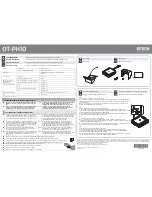
¹
Terminal Interface: If the console_display TRAP_SETTING is enabled, then
the trap will be displayed on the terminal interface. Otherwise, nothing is
displayed.
¹
Trap Log: The trap is put in the trap log.
¹
8239 Model 1 LCD: The MIB II traps are not displayed on the LCD.
¹
Sent to an SNMP Application: The trap is sent via SNMP if there is a valid
entry in the trap community table.
The factory setting for the trap community table is null. To specify where MIB II
traps should be sent, issue the SET TRAP_COMMUNITY RMON/MIB2 terminal
interface command.
RMON Alarms
“Remote Monitoring: RMON, RMON 2, ECAM” on page 8-5 discusses what action
can be taken when an RMON event occurs. The following sections describe what
takes place if you specified that a trap should be generated. All of these actions are
on the local hub only; RMON traps are not forwarded to other 8239 Model 1s in the
stack.
If the trap is generated, viewing takes these forms:
¹
Terminal Interface: If console_display in the Trap Settings is enabled and the
RMON flag in the Trap Settings is enabled, then the trap will be displayed on
the terminal interface. Otherwise, nothing is displayed.
¹
Trap Log: The trap is put in the trap log.
¹
8239 Model 1 LCD: The trap is not displayed on the LCD.
¹
Sent to an SNMP Application: The trap is sent via SNMP if there is a valid
entry in the RMON trap community table. Most RMON managers, like ReMon,
set up a trap community entry in the RMON 2 trap community table. An entry
also can be added to the RMON 2 trap community table by issuing an SNMP
Set request to the appropriate object in the 8239 MIB or by issuing the SET
TRAP_COMMUNITY RMON terminal interface command. All entries in the
RMON 2 trap community table can be displayed using the RMON 2 MIB. The
8239 MIB or the DISPLAY COMMUNITY terminal interface command only
display the RMON 2 entries that were added using the 8239 MIB or the SET
TRAP_COMMUNITY RMON command.
MAC Addresses
Each 8239 is assigned a set of MAC address at the time of manufacture. The first
MAC address in the set is referred to as the
base MAC address. You can identify
this base MAC address using one of the following commands:
¹
DISPLAY HUB
¹
DISPLAY INVENTORY
¹
DISPLAY STACK
The base MAC address is also identified on a label on the front left side of the
8239 shipping carton.
7-16
8239 Setup and User’s Guide
Summary of Contents for 8239 Token-Ring Stackable Hub
Page 1: ...8239 Token Ring Stackable Hub Setup and User s Guide GA27 4209 00...
Page 2: ......
Page 3: ...8239 Token Ring Stackable Hub Setup and User s Guide GA27 4209 00...
Page 8: ...vi 8239 Setup and User s Guide...
Page 10: ...viii 8239 Setup and User s Guide...
Page 28: ...1 8 8239 Setup and User s Guide...
Page 36: ...2 8 8239 Setup and User s Guide...
Page 70: ...5 18 8239 Setup and User s Guide...
Page 102: ...7 18 8239 Setup and User s Guide...
Page 120: ...8 18 8239 Setup and User s Guide...
Page 135: ......
Page 139: ......
Page 140: ...Printed in USA GA27 4209 00...
Page 141: ...Spine information 8239 Token Ring Stackable Hub Setup and User s Guide...
















































